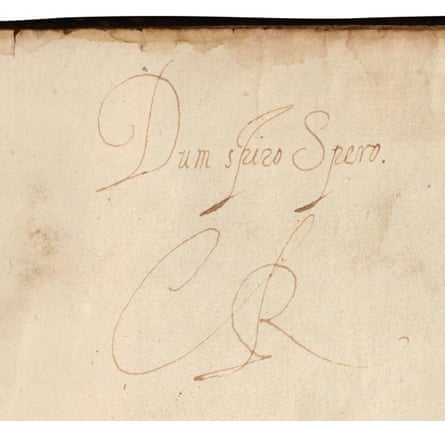“While I breathe, I hope.” This “cryptic message” discovered in a copy of The Faerie Queene reveals it to be one of the books Charles I read during his final imprisonment. The volume is just one of the treasures from the library at West Horsley Place that the television presenter Bamber Gascoigne is selling at auction to raise money to turn it into a cultural centre.
“It just looked like an interesting first edition, probably of some value to a collector,” Gascoigne said, “but Sotheby’s cleverly discovered the writing and the phraseology meant it was one of the books Charles I had been reading while waiting for his execution.”
The motto appears on the flyleaf in Latin, “Dum spiro Spero”, with the graceful initials “CR” underneath.
“He’d write this small cryptic message in his books, as if for the future,” Gascoigne continued, “like putting a glass bottle in the sea. And Sotheby’s picked it up.”
When Gascoigne’s great aunt Mary, Duchess of Roxburghe died in 2014 at the age of 99, she left him a crumbling 15th-century manor house. After deciding to establish a centre for the performing and visual arts on the site, Gascoigne transferred ownership to a charitable trust.
Much of the library assembled by Mary’s grandfather Richard Monckton Milnes passed to Trinity College in Cambridge, but a vast number of books remained. So the former host of University Challenge called in Sotheby’s to see if the collection could help to raise money for repairs.
“It’s a house absolutely crowded full of books,” said Dr Gabriel Heaton at the auctioneers, which will auction a selection of the volumes in London on 9 July. “There’s almost an overwhelming quantity.”
Among these volumes was the inscribed copy of Edmund Spenser’s epic poem, which belonged to Thomas Herbert, who acted as a jailer and an attendant to the king while he was imprisoned on the Isle of Wight between 1647 and 1648.

“It is a very distinctive inscription, and had the initials CR underneath it,” said Heaton, “it’s something Charles I put in many of his books while in prison … When we saw it, we thought my goodness.”
Herbert’s own memoir of the time comments that “in many of [Charles’s] books he delighted himself with the Motto Dum Spiro Spero; which he wrote frequently as the Emblem of his Hopes as well as Endeavours for a happy Agreement with his Parliament.”
According to Herbert, “the sacred Scripture was the Book he most delighted in” but the Spenser was for “alleviating his Spirits after serious Studies”.
It now has a guide price of between £30,000 and £50,000.
“There are collectors who want things like this, and our hope as a charity is that two of them get locked in furious combat,” said Gascoigne.
Other titles in the Sotheby’s auction include a “very rare” book by Florence Nightingale about the Crimean war and the death rates in the hospitals there. Privately printed and never available in shops, the book is believed to have been given by Nightingale to Monckton Milnes, who had unsuccessfully wooed her.
Heaton said the auction house had also discovered a number of letters by authors including Elizabeth Gaskell, Charles Dickens and Thomas Hardy enclosed in the books. In a copy of Gaskell’s novel Ruth, a letter from the author thanks Monckton Milnes for approving of the book, adding that she was “so anxious about her, and took so much over writing it, that I lost my own power of judging, and could not tell whether I had done it well or ill … I tried to make both the story and the writing as quiet as possible.”
“It gives a sense of how much Monckton Milnes was at the heart of Victorian literary London,” said Heaton.
“The wealth of the library, the treasures in it, were lurking there waiting to be discovered,” said Gascoigne. “I hadn’t been in the library, I hadn’t been upstairs [before the Duchess’s death]; the whole inheritance of it was a complete and utter mystery.”
Admitting to feeling very daunted after inheriting West Horsley Place, he said that he and his wife’s “dream for it is that it becomes a much-enjoyed cultural place for the whole community”. His great aunt “suggested to the solicitor who made the will that the house should be sold after her death as it was so impossible a project,” he said. “But we thought we should have a go.”
